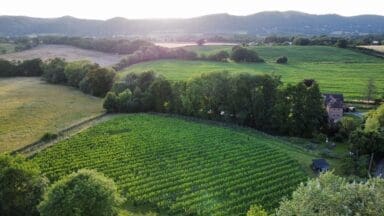
Collectively, known as the Malvern Hills Vineyards, the group grow 14 grape varieties across more than 68 acres. The six are: Three Choirs, Chase End, Bromesberrow Place, Foxbury Fields, Marlbank (pictured) and Two Beacons.
The new collaboration seeks to raise awareness and interest in this burgeoning sector, which is said to have deep roots in the Malvern Hills region as grapes were cultivated in the area during Roman times. Grapevines are taking over where apples, pears and hops used to grow.
The youngest vineyard in the Malvern Hills Vineyards collaboration is Marlbank, where Manager Jeremy Macklin has experience working closely with vineyards in France. “When I moved here in 2020, I discovered the marl soils were very similar to those in Burgundy, which produces excellent pinot noir grapes, so it was a bit of a ‘no-brainer’ to plant 1,500 pinot noir vines in a field where apples and pears used to grow.”
Heather Williamson, cofounder of Foxbury Fields Vineyard added: “The character and story of each vineyard is unique, but what we all have in common is people with a passion for the art and craft of viticulture, and a respect for the soils that nurtures their vines.”
UK wine country
The UK wine industry is experiencing substantial growth. The English market was initially focused on sparkling wines but has market matured to produce quality whites and even reds.
The area of the UK planted to vines has surged by around 75% over the past five years to almost 10,000 acres. Often compared to California in the 1970’s, annual production has increased by 130% to over 12 million bottles. There are now approximately 950 vineyards in the UK. The production epicentre is Kent, Sussex and Surrey, but vineyards extend to Essex, Norfolk, Yorkshire and some 100 in Wales.
For small scale producers with seven to ten acres of vines, running a profitable business is challenging, with margins coming from collaborations such as the Malvern Hills group, or cellar-door sales by attracting visitors for sales by the glass. According to WineGB’s ‘UK Wine Tourism in 2024 report’, visits to vineyards and wineries have risen by 55%, with vineyards and wineries now actively being involved in wine tourism.
The UK’s vineyard sector is proving to be sound investment potential for international wine brands, especially since several businesses have been able to grow to the size required to warrant a sizeable investment. The UK is also increasingly viewed as a climate change hedge by producers in parts of Europe where rising temperatures and more erratic weather conditions are making it more difficult to produce traditional wines.
In terms of production Williamson added: “We’ve had some great production years recently including 2023, which was pretty near perfect in terms of the weather, the harvest and the number of bottles produced. 2024 proved a bit challenging with all the wet weather at the start of the year so it’s going to be interesting to see how we all fare in 2025, especially with the drier year we’ve had so far.”
Promising 2025 vintage
With the warmest summer on record this year, UK winemakers are cautiously optimistic about delivering a top 2025 vintage for both sparkling and still wines. Though for those not on chalk (which retains water), or with (predominantly) young vines, the volatile temperatures and drought could have proved problematic.
Samuel Philippot, Vineyard Manager at the Hampshire based, Candover Brook Vineyard explained that the challenge this year was in choosing the (earlier) harvest date, which for this vineyard started last week.
“Usually in Hampshire we try to push the maturity to the maximum to get the right level of acidity and sugar. This year, we’ll have to monitor these two elements evolution very closely to make sure we pick at a date that will suit the wine types wanted and the house’s style consistency. Powdery mildew can be a serious problem. It doesn’t need the rain to develop, humidity caused by morning due and hot temperatures are all it needs to thrill in susceptible varieties like the ones we have.”
Yields are expected to be good this year, providing an opportunity for UK wineries to bounce back from rain-hit volumes in 2024. Philippot added: “Yield variation in the UK is huge, but is more often linked to spring frost, rain during flowering, rain during ripening. Apart from sites badly affected by powdery mildew this year, I don’t think many vineyards have suffered major yield reduction this year.”

